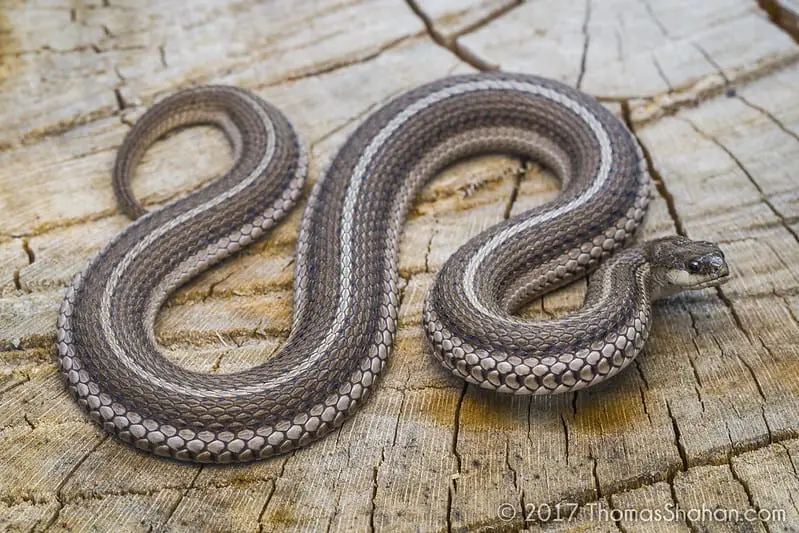The lined snake is a small nonvenomous snake found in the Central United States. The mostly dark snake usually comes in a range of brown-shades and has three lighter longitudinal stripes along its body. It is therefore sometimes confused with similar-looking species of the garter snake.
Description
The base coloration of lined snakes is usually brown, dark olive green sometimes even black. A lighter colored longitudinal stripe runs along the middle of the back. The stripe is usually light brown or yellow. Two more, broader longitudinal stripes run along both sides of the snake. The belly is cream-colored or white with two lines of black crescent-patterns running along the center.

The lined snake is sometimes confused with various species of garter snakes, especially the Plains garter snake and the wandering garter snake, a subspecies of the western terrestrial garter snake. The snakes can best be distinguished by their sizes as lined snakes are small snakes and most garter snakes much longer. Also, the head of garter snakes can be quite broad while lined snakes have a narrow head. Garter snakes often have a checkered pattern between the stripe on the center of the back and the stripes on the sides, lined snakes are more uniformely colored. However, lined snakes can also have darker, even black spots in the darker area between the stripes.

Size
The lined snake is a small snake with adults reaching an average length of 14 inches (35 cm). The largest ever recorded lined snake measured 21 inches (53 cm). Since the patterns can sometimes look similar to garter snakes, the size is a great measure to distinguish the two genera.
Hunting Behavior and Habitat
Lined snakes live in hilly parts of the prairie as well as in smaller forest areas. They are also found in the outskirts of human communities and often hide under rocks, wood or under other debris. Due to their small size, they feed mostly on earthworms and insect larvae.

Bite and Defense
The lined snake is a small nonvenomous snake that is not dangerous for humans or larger pets. Its first instinct when a threat appears is to escape and to hide under rocks or in another safe place. Even if handled, it does usually not resort to biting and would rather release a foul-smelling musk. With its small teeth and head, it is unlikely that the snake would succeed to bite through human skin.
Lined snake range in the USA
This snake occurs with several populations in the central United States in the following states: Minnesota, Wisconsin, Illinois, Iowa, Missouri, South Dakota, Nebraska, Colorado, Kansas, Oklahoma, New Mexico and Texas.
Subspecies of Tropidoclonion lineatum and their range
- Tropidoclonion lineatum lineatum – northern lined snake
- Tropidoclonion lineatum annectens – central lined snake
- Tropidoclonion lineatum mertensi – Mertens’ lined snake
- Tropidoclonion lineatum texanum – Texas lined snake
Other Common Names
Commonly, Tropidoclonion lineatum, the lined snake is also known as the common snake, grass snake, line snake, striped snake, swamp snake, ribbon snake and streaked snake. It’s similar appearance to the garter snakes has also earned it the name dwarf garter snake.
Scientific classification of Tropidoclonion lineatum
- Kingdom: Animalia
- Phylum: Chordata
- Class: Reptilia
- Order: Squamata
- Suborder: Serpentes
- Family: Colubridae
- Genus: Tropidoclonion
- Species: Tropidoclonion lineatum